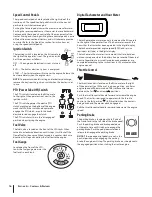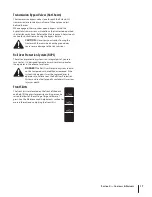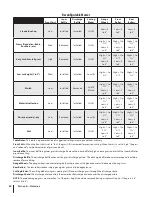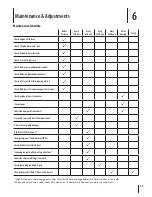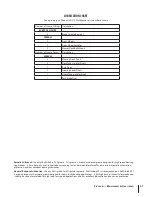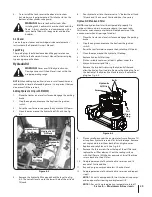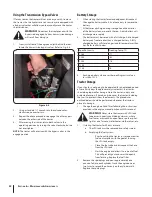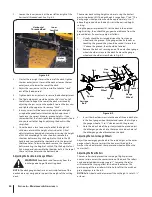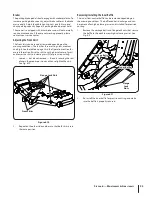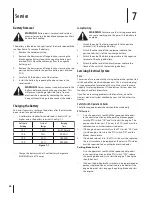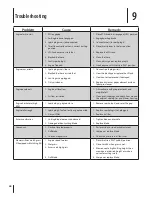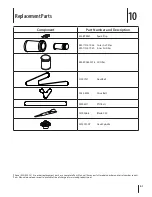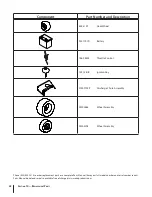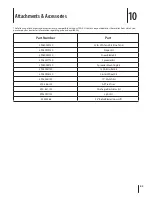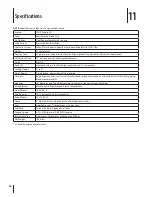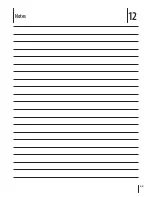
30
s
ectiOn
6— M
aintenance
& a
djustMents
engine and re-check hydraulic oil. If oil appears foamy or
contains excessive air bubbles, DO nOT OPERATE UnIT.
Contact service technician.
Contaminants or foreign matter in the oil will also damage the
pumps . To prevent this:
Use a filter that captures particles as small as 25 microns or
•
25 millionths of a meter in diameter.
Be very careful when you remove or repair a component in
•
the hydraulic system. Thoroughly clean off any component
before you work on it.
Plug the ends of any hose or line you remove with a rubber
•
or plastic plug.
Use plastic caps to seal off the ends of hydraulic fittings.
•
Place any component you remove in a clean plastic bag so
•
it can’t pick up dust or dirt.
Clean your hands frequently when working on the
•
hydraulic components.
NOTE:
The pumps are not owner-repairable. If a pump fails,
contact your Service Center. Do not disassemble the pump.
Hydraulic System
Hoses
Check the hoses from the hydraulic oil tank to the oil filter to
the hydraulic lines daily for leaks or abrasion and replace any
damaged hoses. Make certain there are no kinks or twists in any
hose. Look for a flattened condition or any leaks and repair or
replace as necessary. A flattened or leaking suction hose will
permit cavitation to develop which can destroy the pumps in a
short time.
General Battery Information
WARNING!
— Should battery acid accidentally splatter into
the eyes or onto the skin, rinse the affected area
immediately with clean cold water. If there is any
further discomfort, seek prompt medical attention.
— If acid spills on clothing, first dilute it with clean
water, then neutralize with a solution of ammonia/
water or baking soda/water.
— NEVER connect (or disconnect) battery charger
clips to the battery while the charger is turned on, as
it can cause sparks.
— Keep all sources of ignition (cigarettes, matches,
lighters) away from the battery. The gas generated
during charging can be combustible.
— As a further precaution, only charge the battery
in a well ventilated area.
— Always shield eyes and protect skin and clothing
when working near batteries.
— Batteries contain sulfuric acid and may emit
explosive gases. Use extreme caution when
handling batteries. Keep batteries out of the reach
of children.
Battery Maintenance
The battery is filled with battery acid and then sealed at
•
the factory. However, every 50 operating hours remove the
fill caps and check the level of the liquid electrolyte in the
battery. If the level in any of the six cells has dropped below
the bottom of the split ring inside the fill hole, refill the cell
with distilled water.
Spray the terminals and exposed wire with a battery
•
terminal sealer, or coat the terminals with a thin coat of
grease or petroleum jelly, to protect against corrosion.
Always keep the battery cables and terminals clean and
•
free of corrosion.
Avoid tipping. Even a sealed battery will leak electrolyte
•
when tipped.
Tire Maintenance
Check the tire air pressure before each use. Inflation pressure
of the rear tires is important for stability while the mower is in
operation. If the tire diameter is not equal between the two tires,
the mower will pull to one side. Keep the tires inflated to the
recommended pressures. Improper inflation will shorten the tire
service life. See the tire side wall for proper inflation pressures.
Observe the following guidelines:
Do not inflate a tire above the maximum pressure shown
•
on the sidewall of the tire.
Do not reinflate a tire that has been run flat or seriously
•
under inflated. Have a qualified tire mechanic inspect and
service the tire.
Balance inflation pressure between the rear tires to heLPG
•
maintain straight travel (see tire side wall for proper
inflation pressure).
Keep the valve caps tightened to prevent air pressure loss.
•
Inflation Pressure
Traction Tires — 20 psi max; 10-12 psi recommended
Front Wheel — 25 psi max; 20-25 psi recommended
Cutting Deck Ball Wheels — Solid Polyurethane
Leaking Tires
When a flat tire occurs, repair or replace immediately. The normal
procedure is to remove the wheel and replace it. If a tire is
getting soft, park the mower on the nearest level, paved area.
Rear Tire
1.
Put blocks on each side of the opposite traction
a.
wheel and jack up the tire that leaks about an inch
off the ground.
Loosen and remove the lug nuts and remove the
b.
wheel.
Mount a wheel and tire, replace the lug nuts, and
c.
using a torque wrench, tighten them to 60 ± 10
ft-lbs.
Содержание Tank S S7237
Страница 45: ...Notes 12 45 ...

